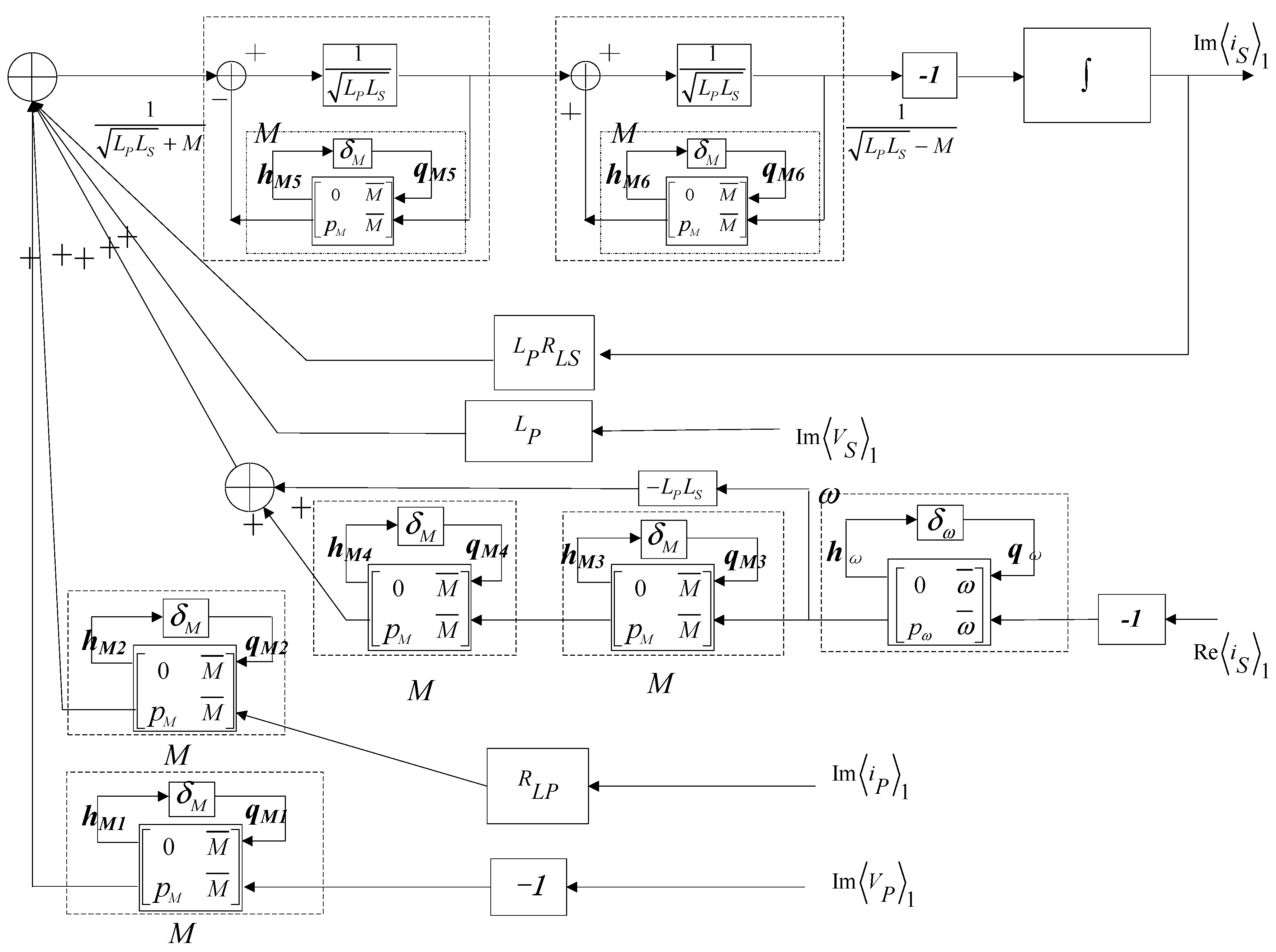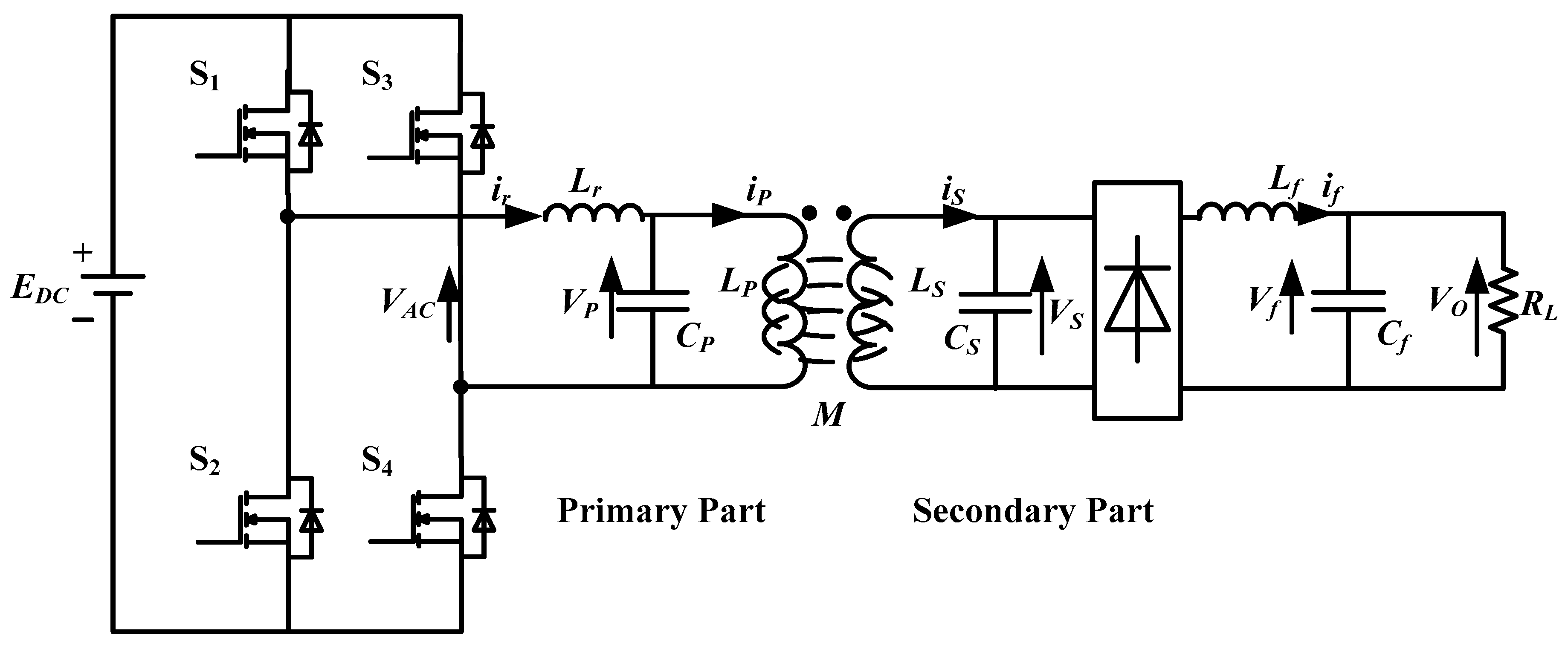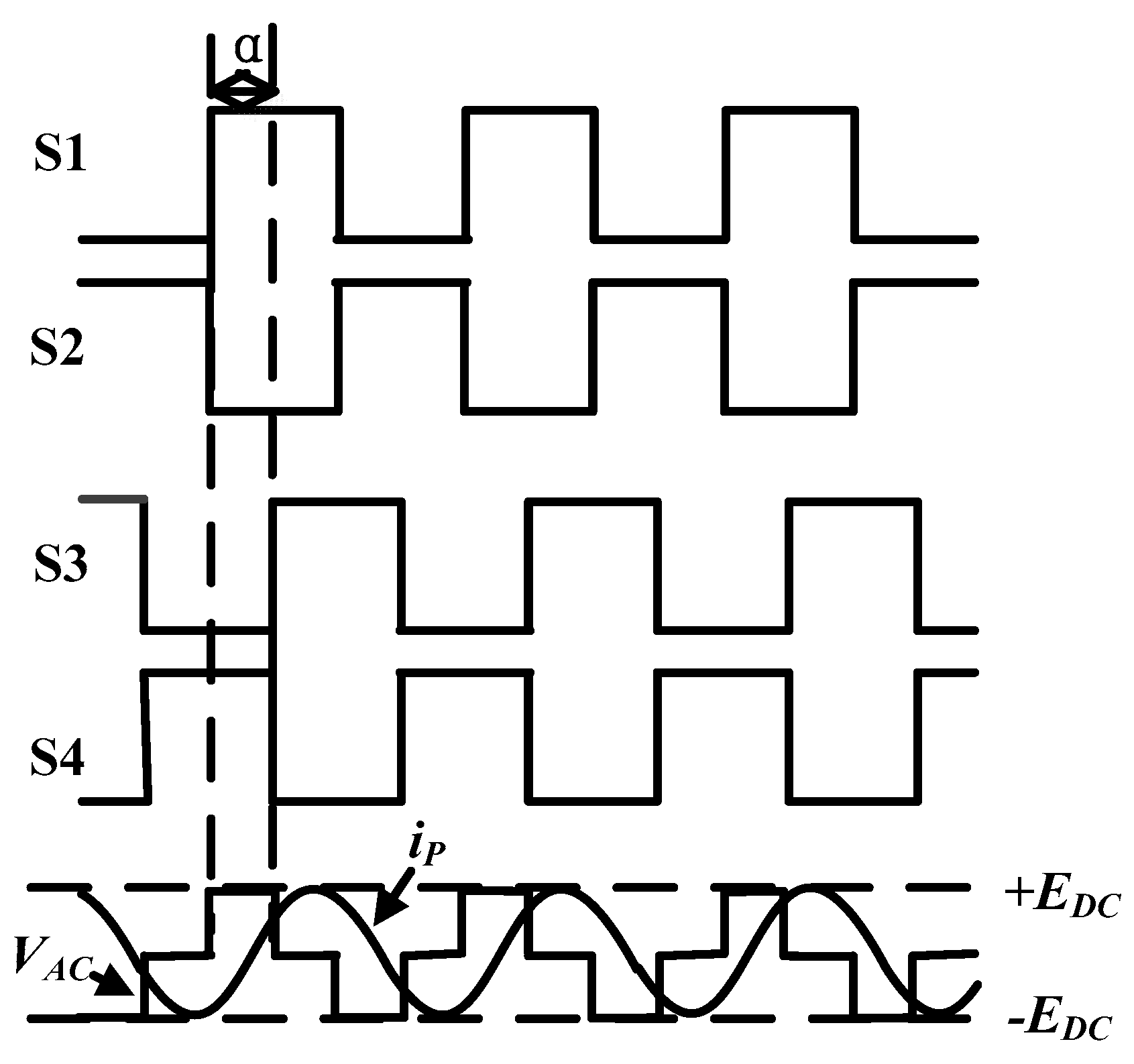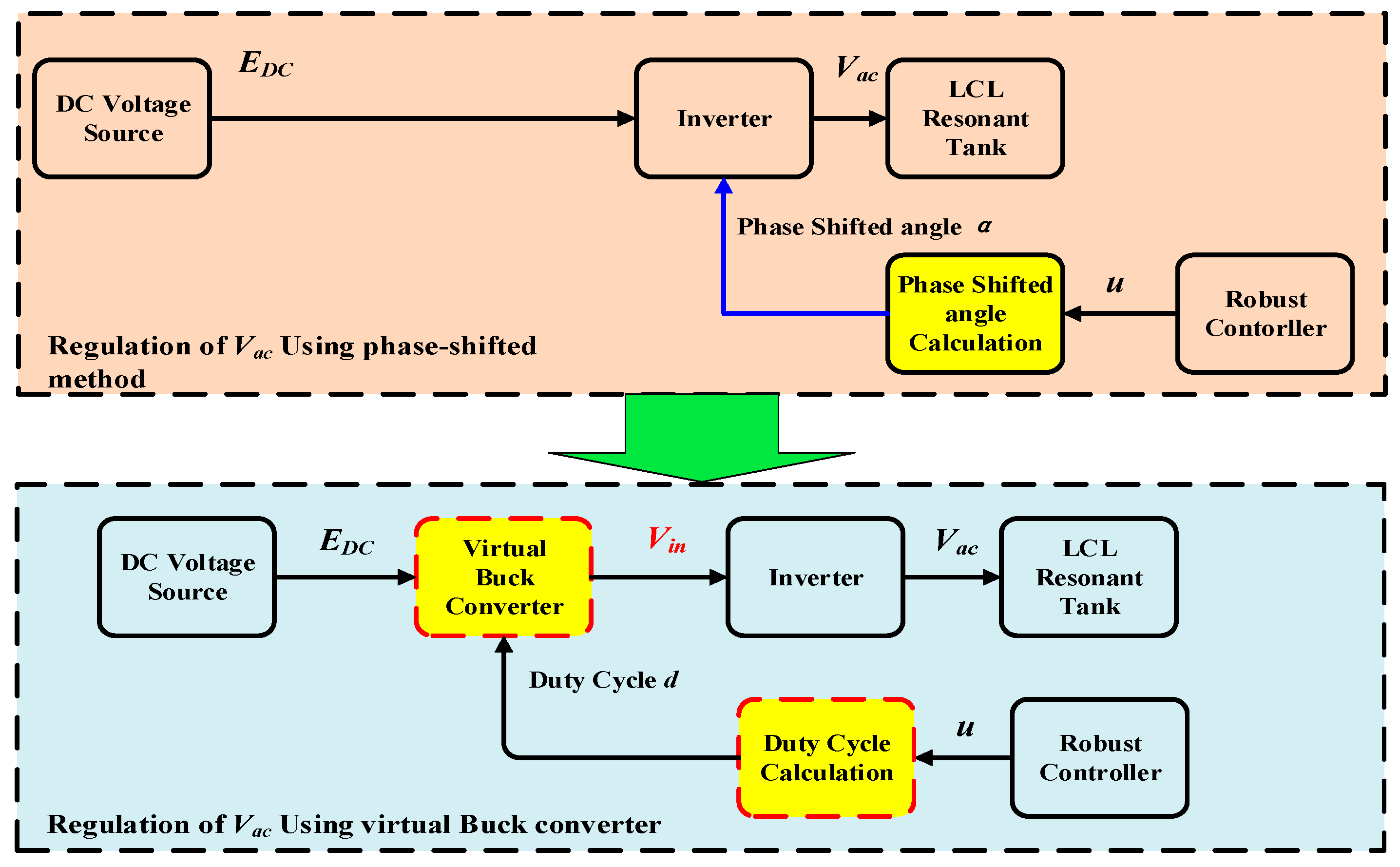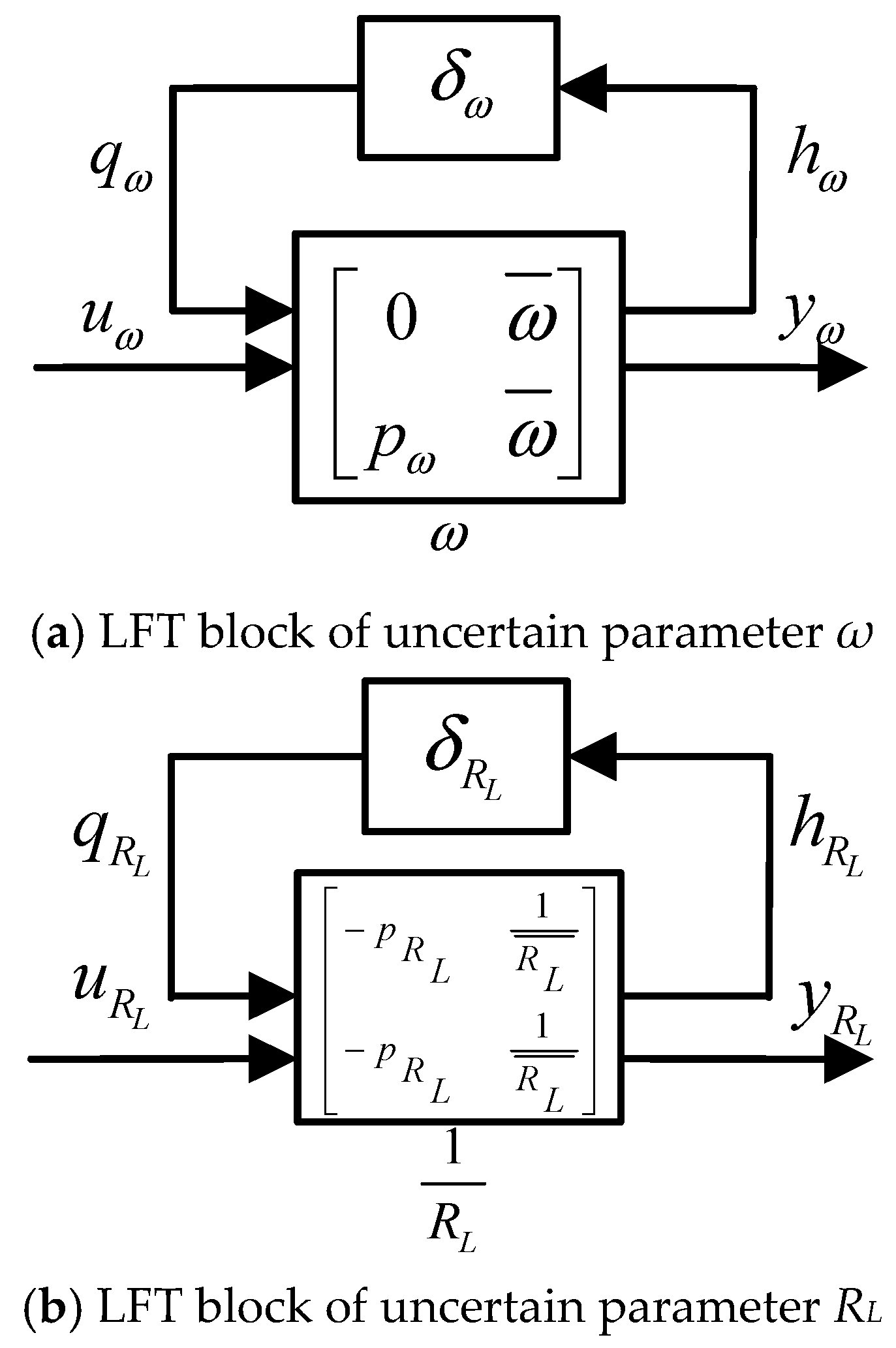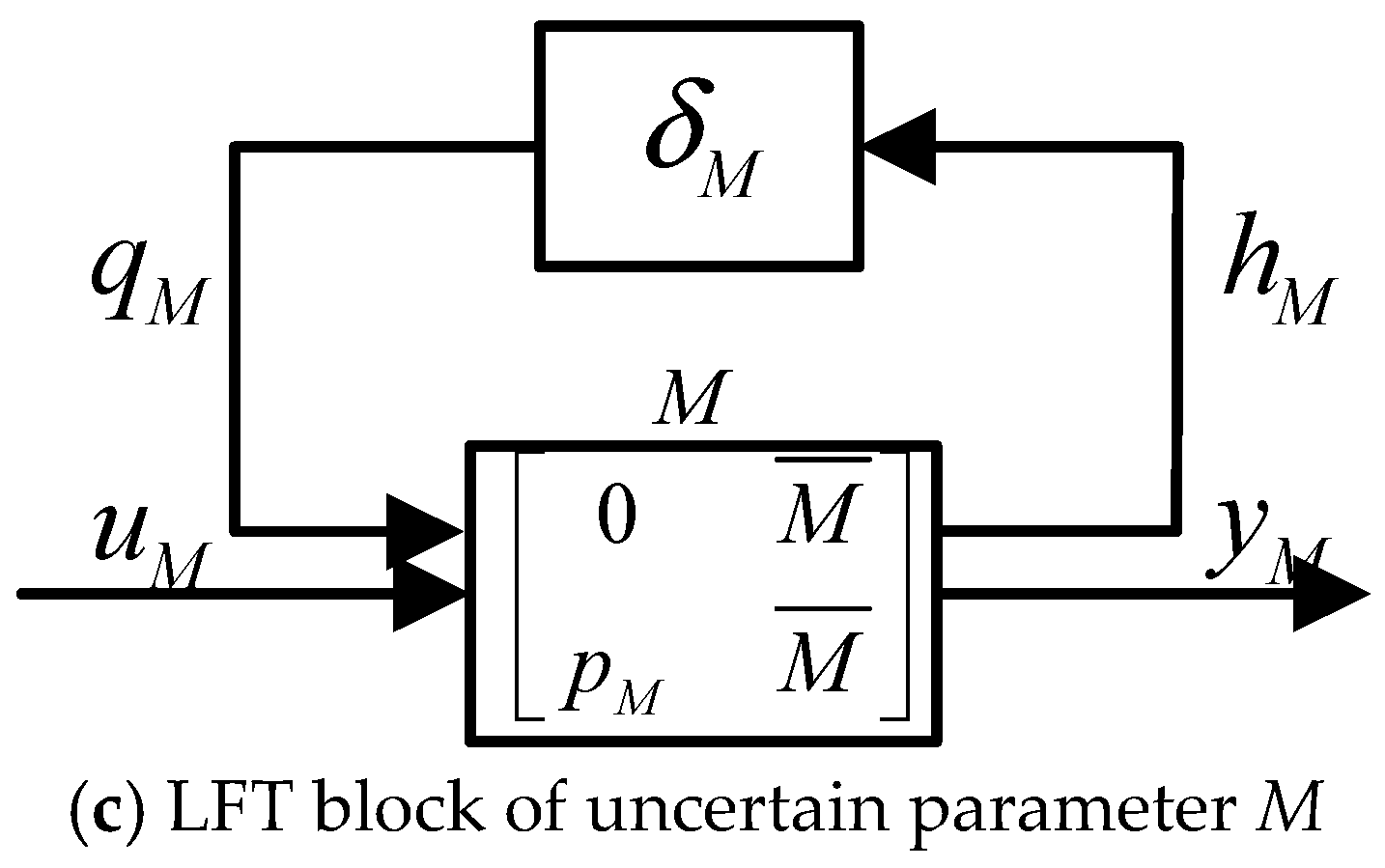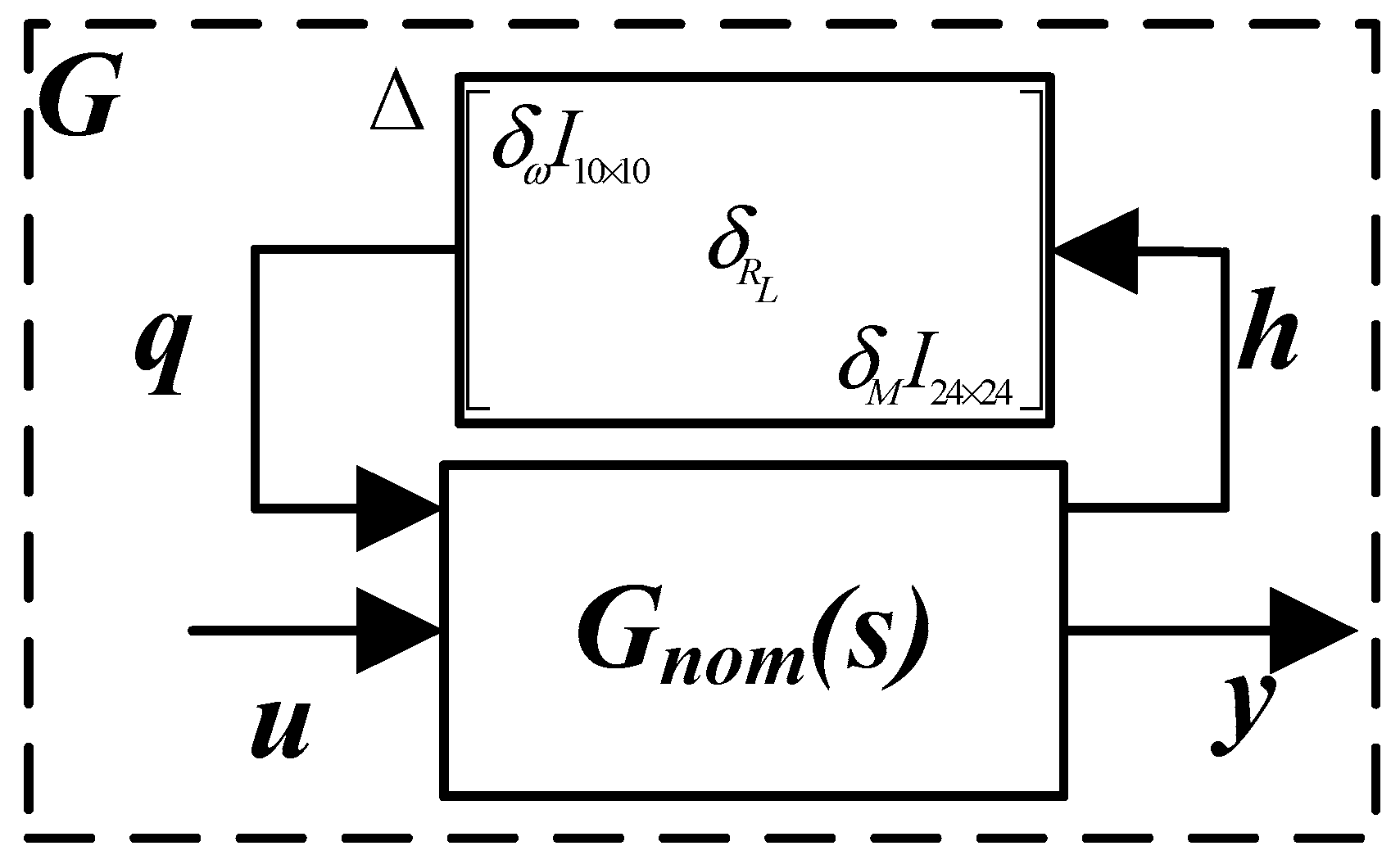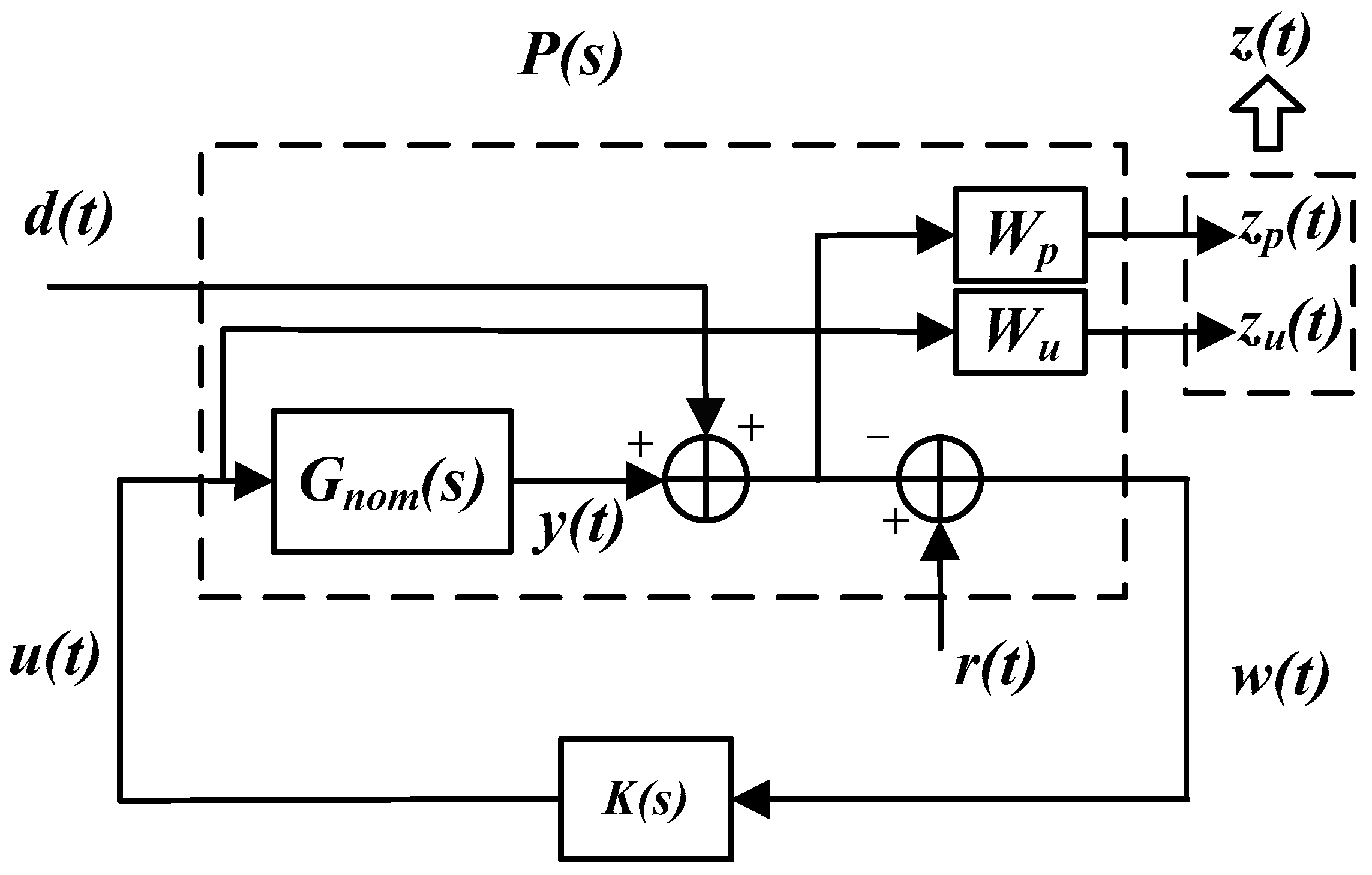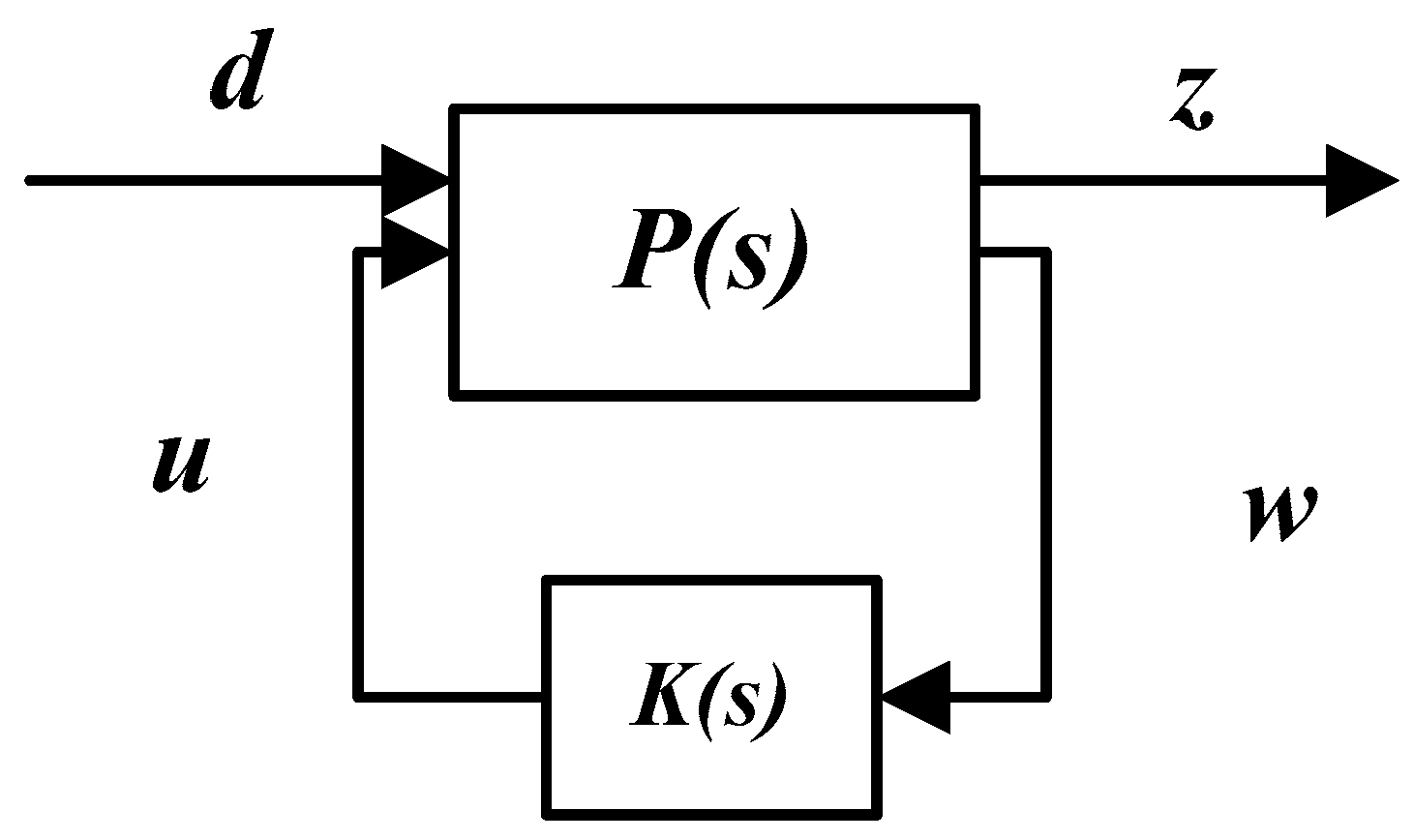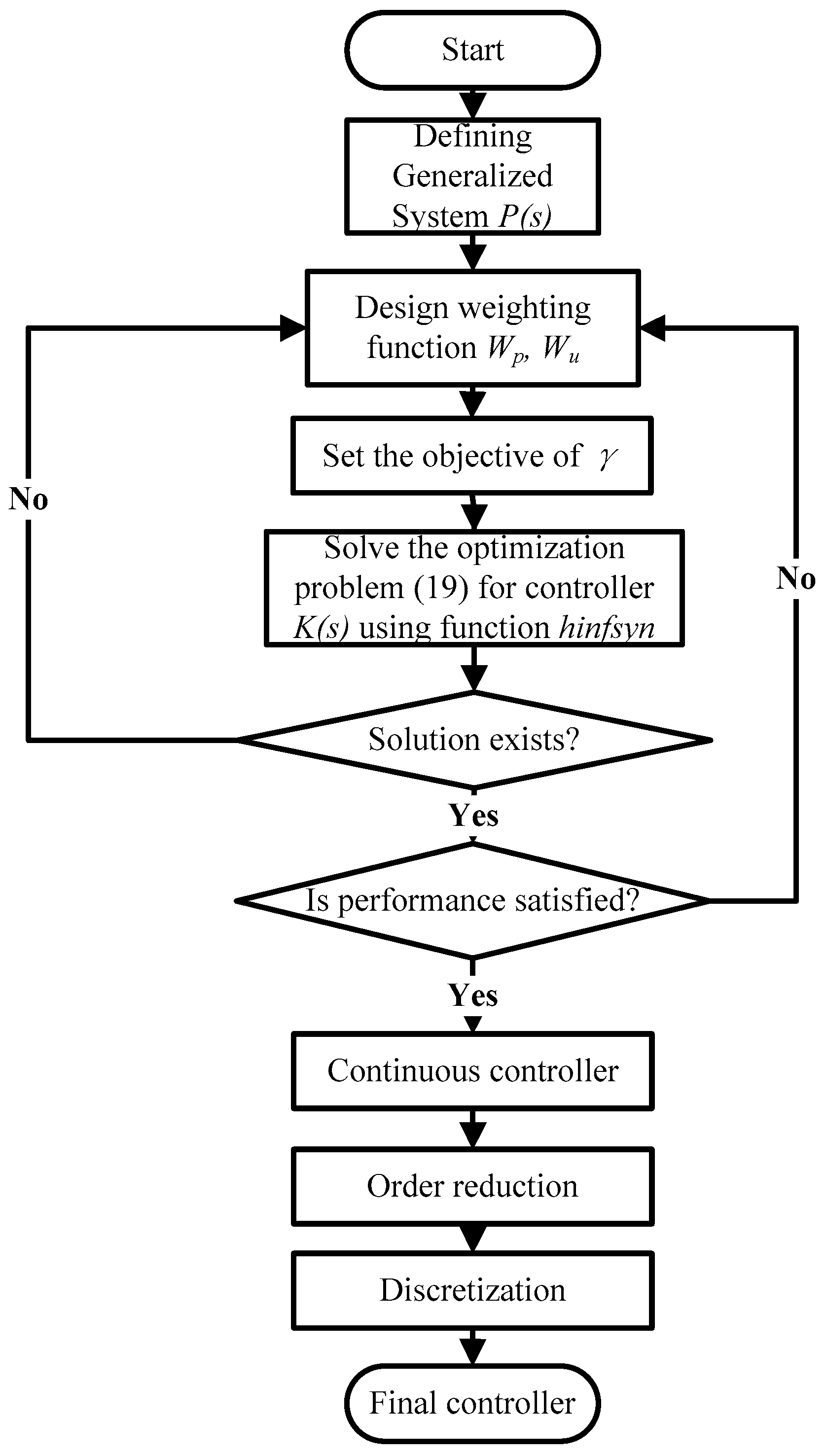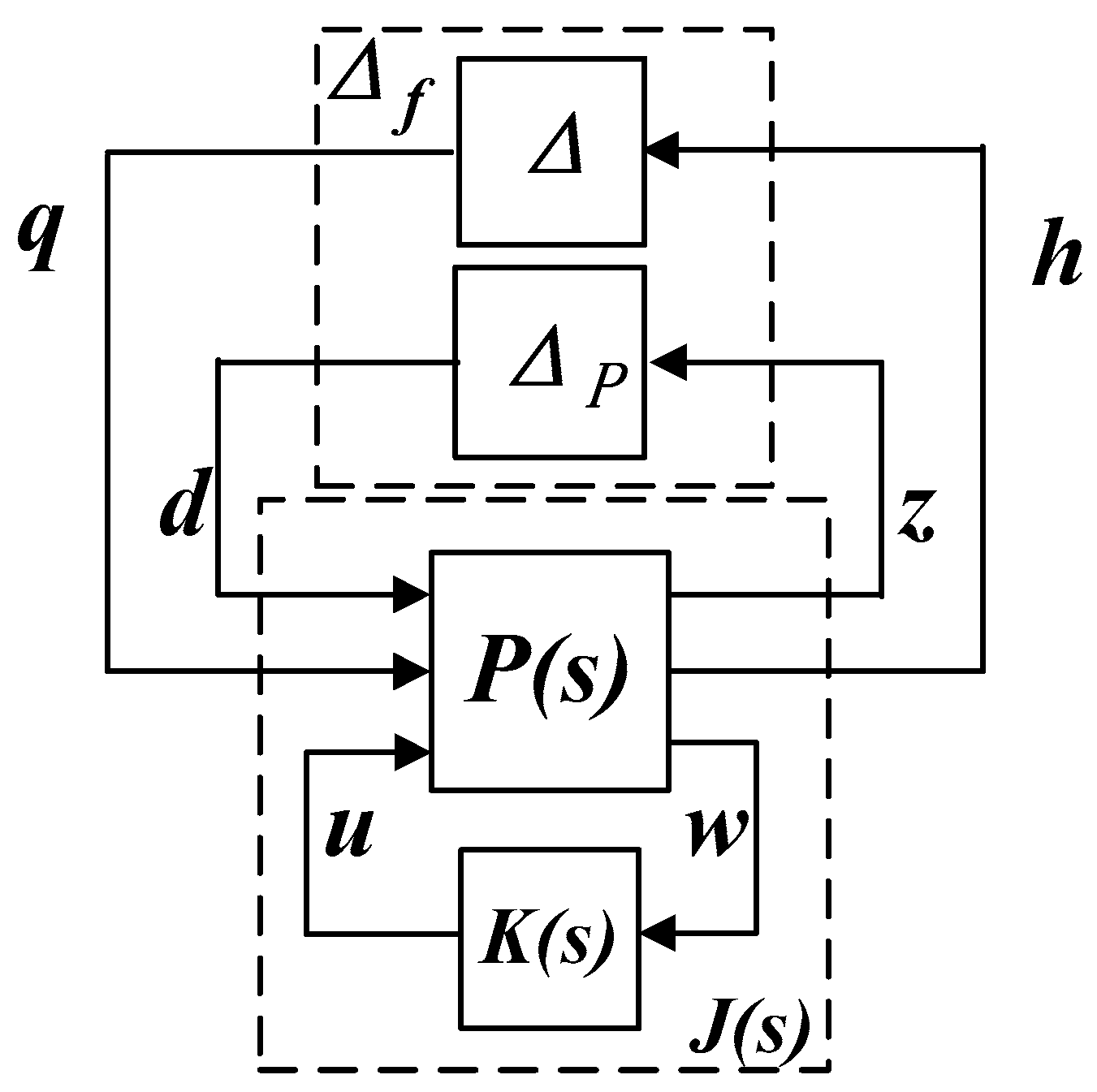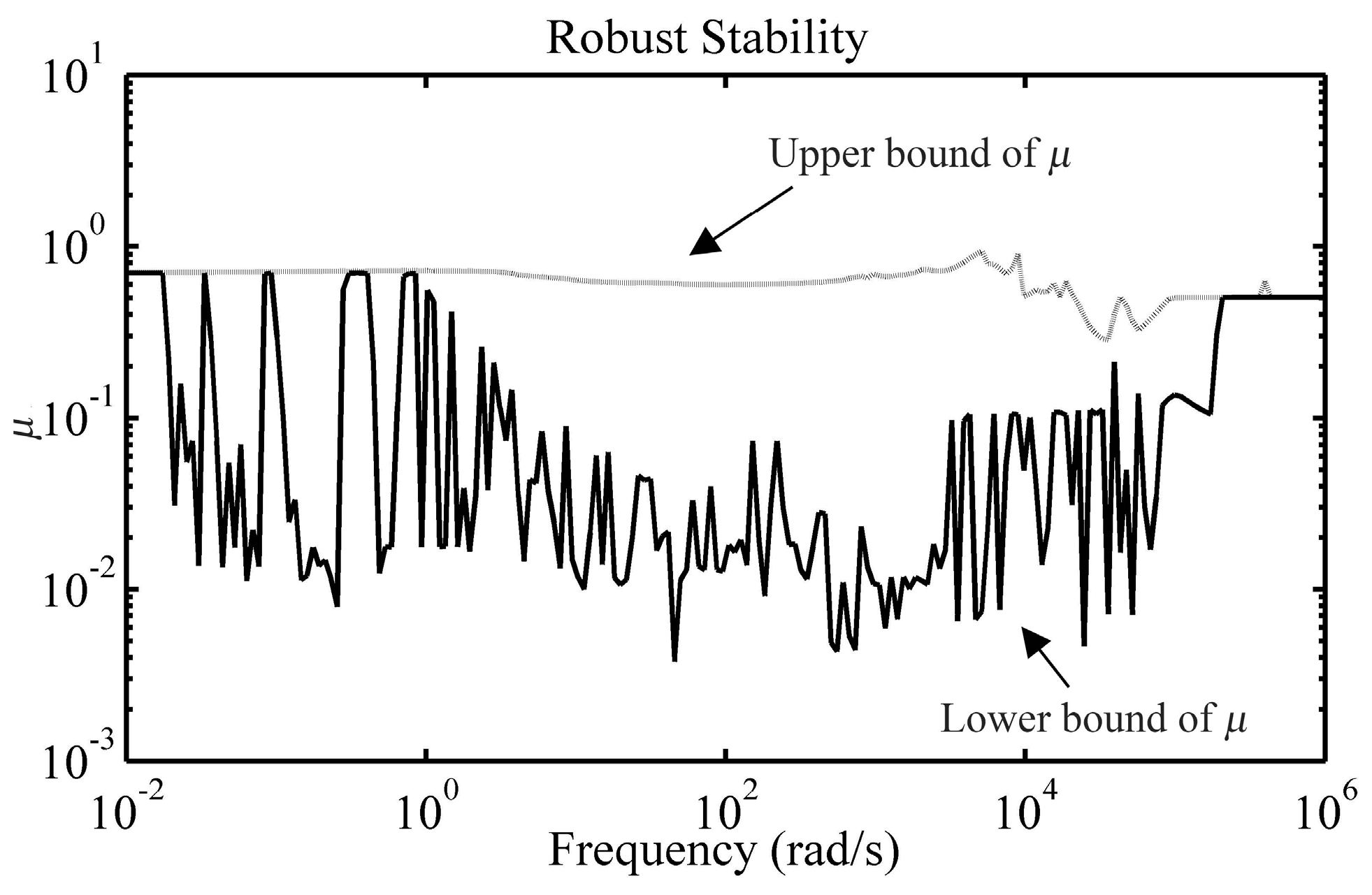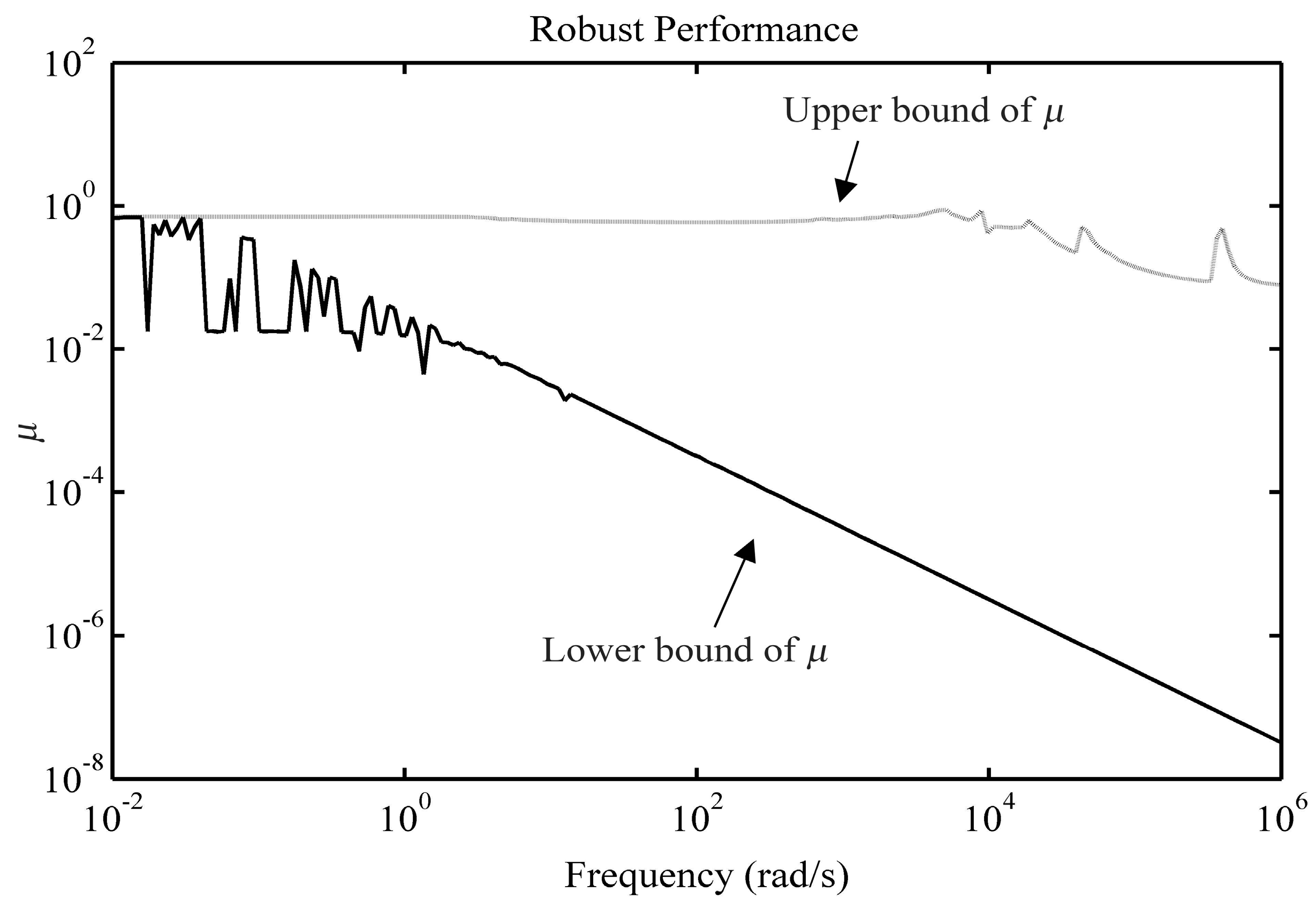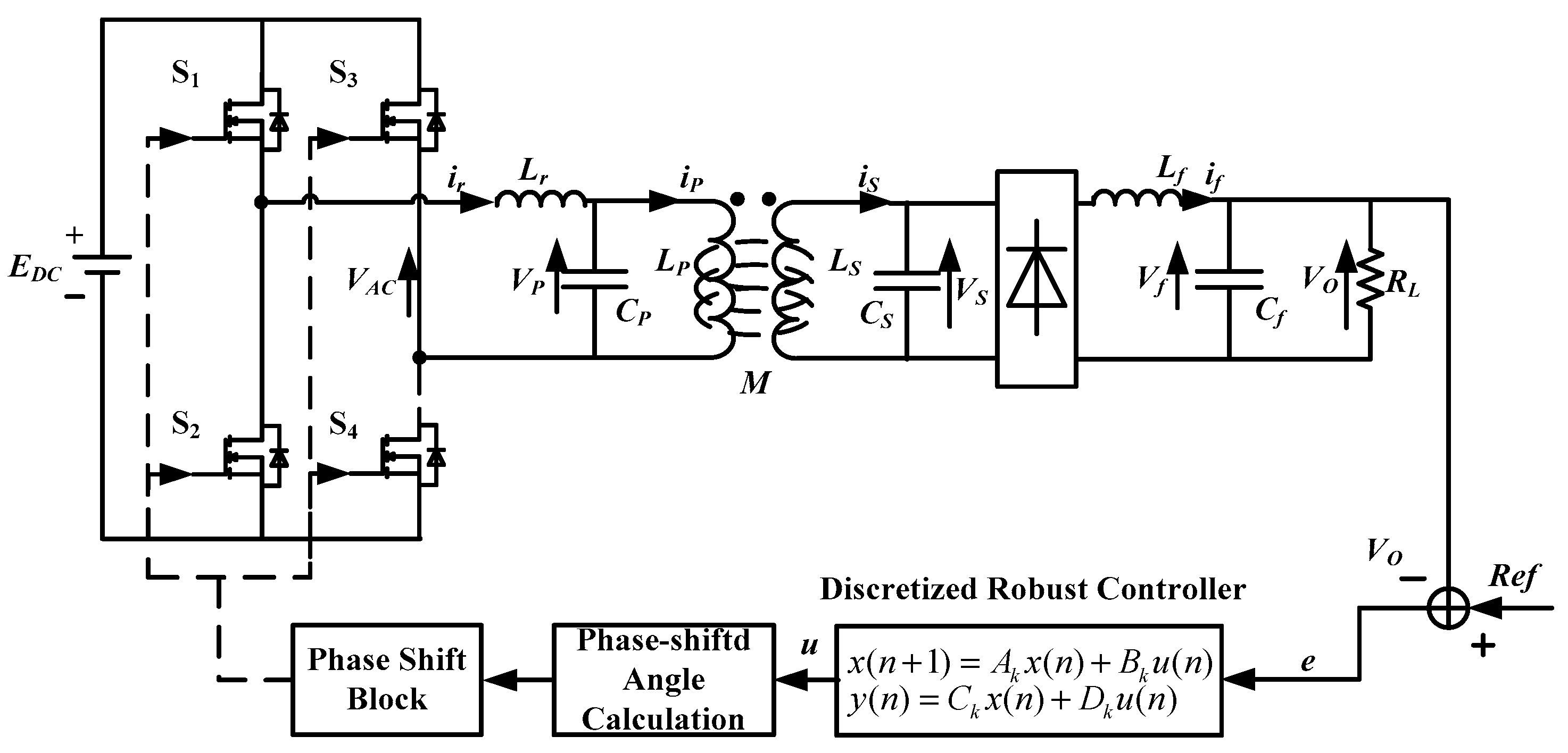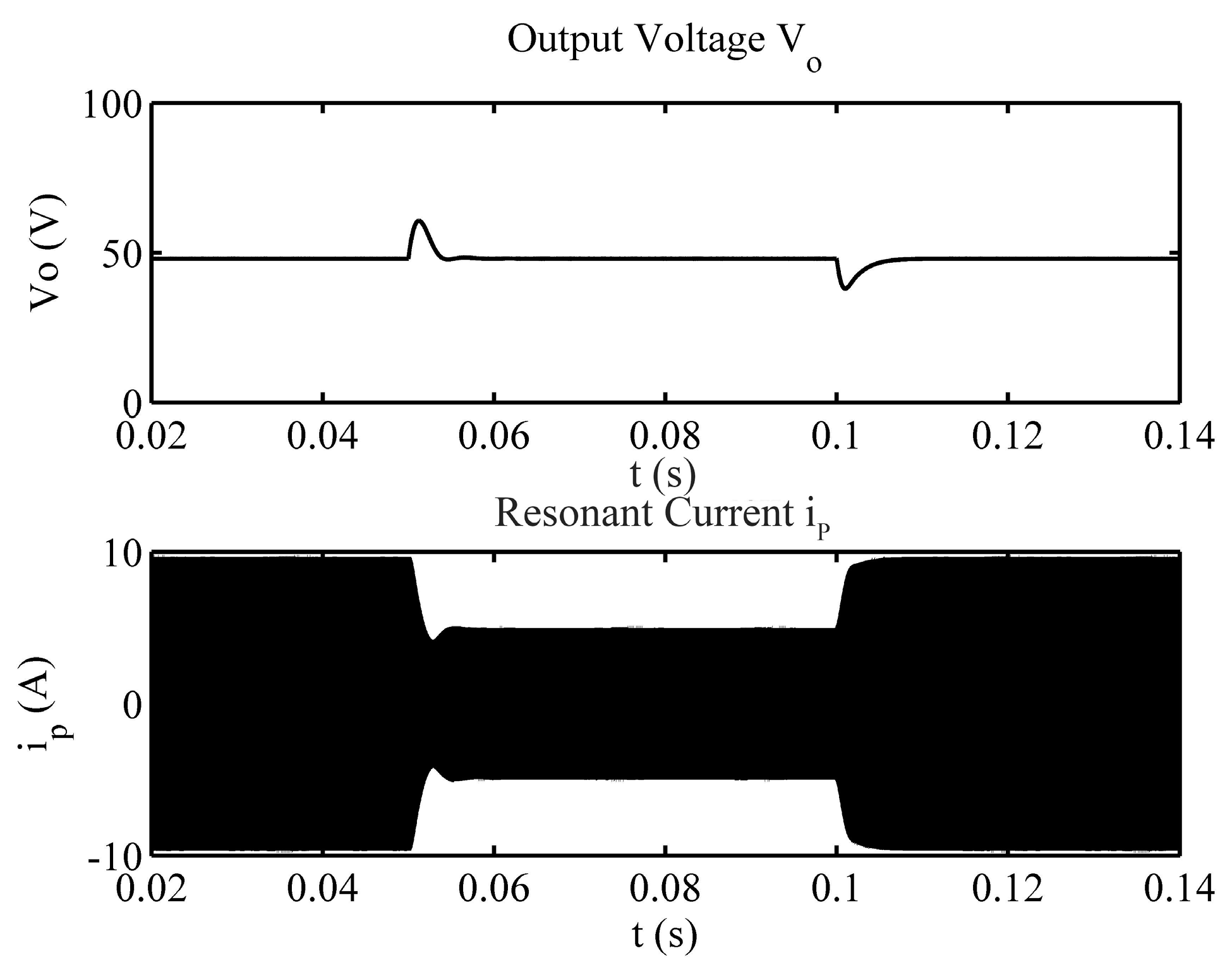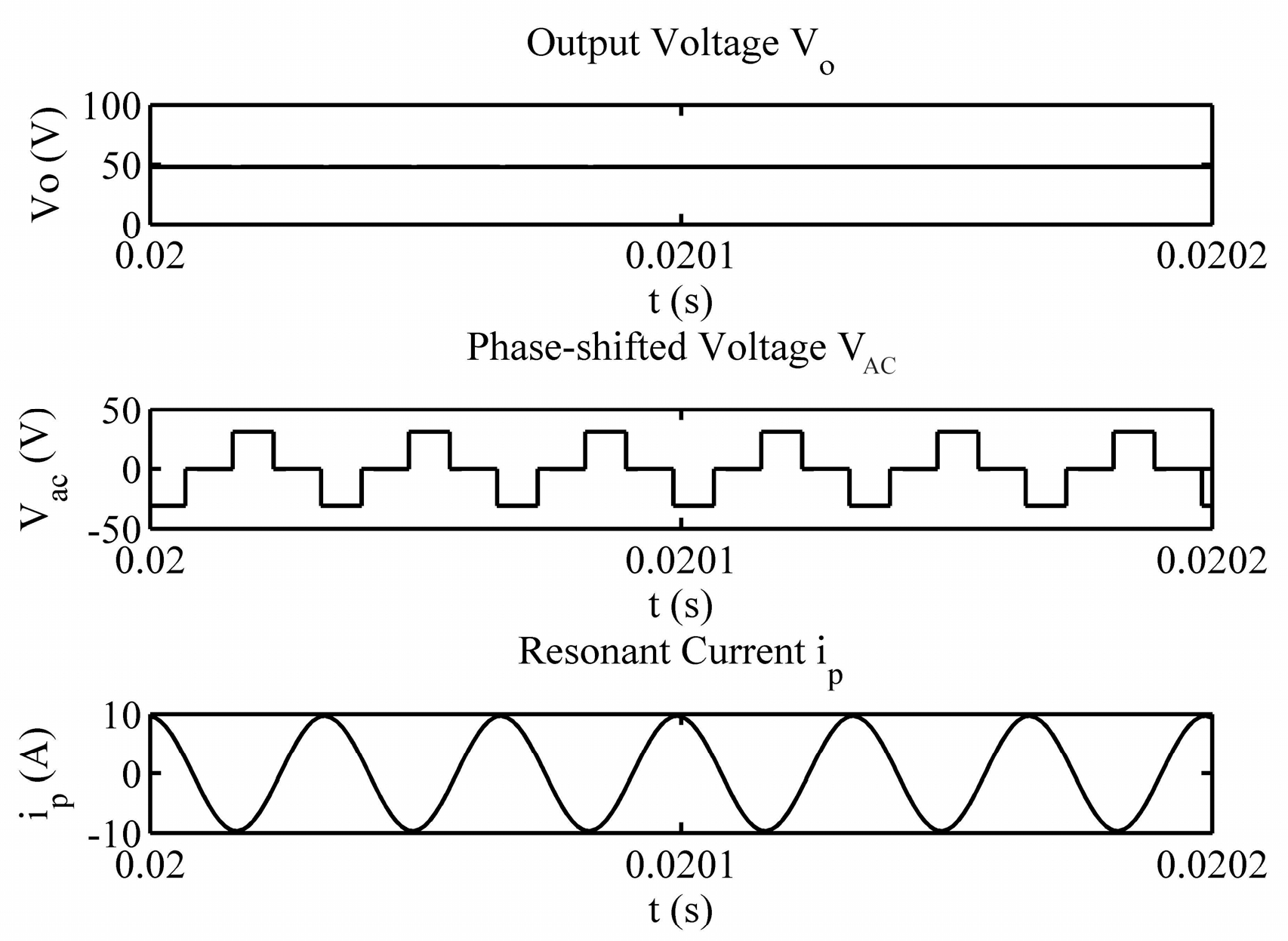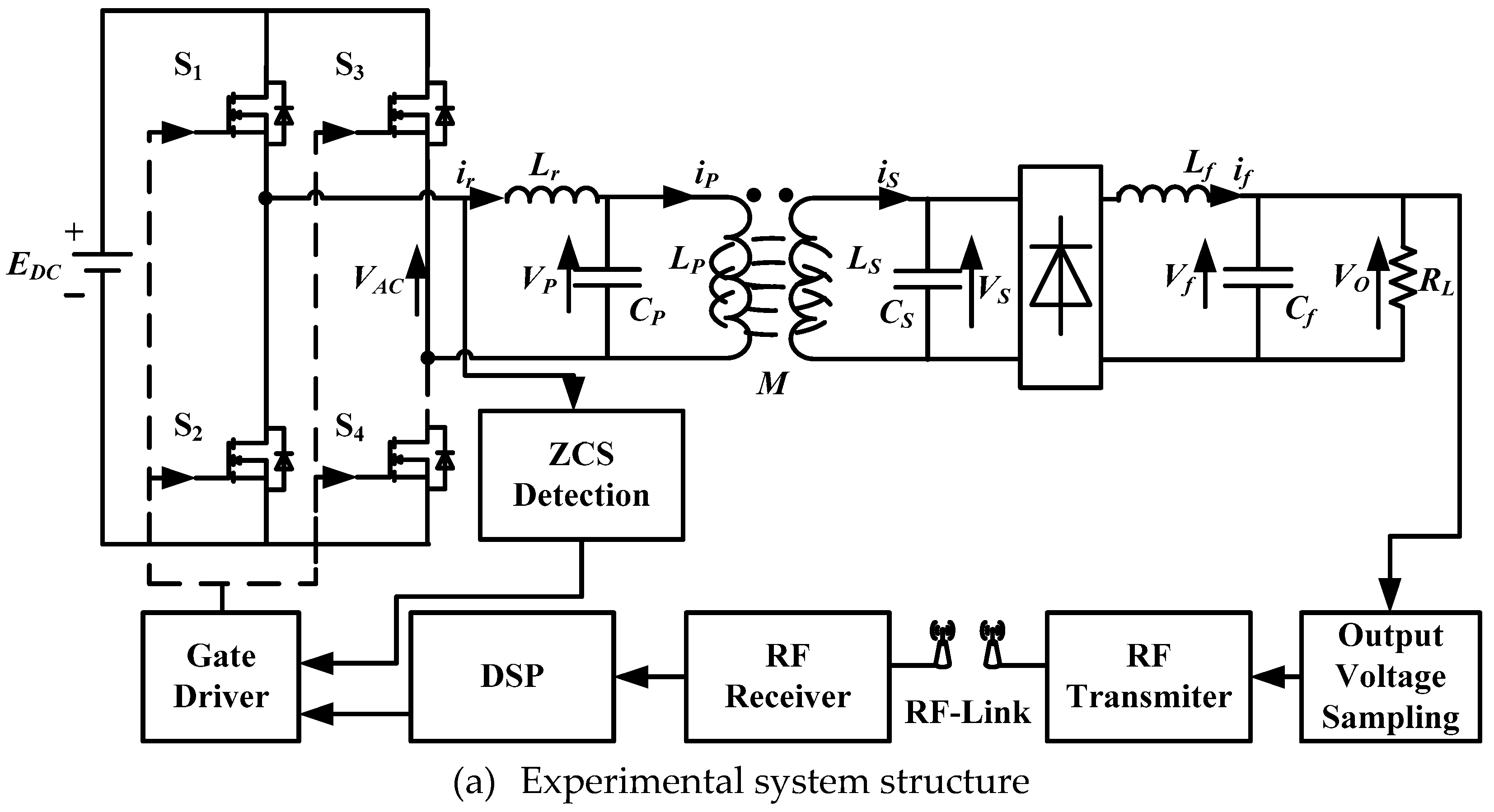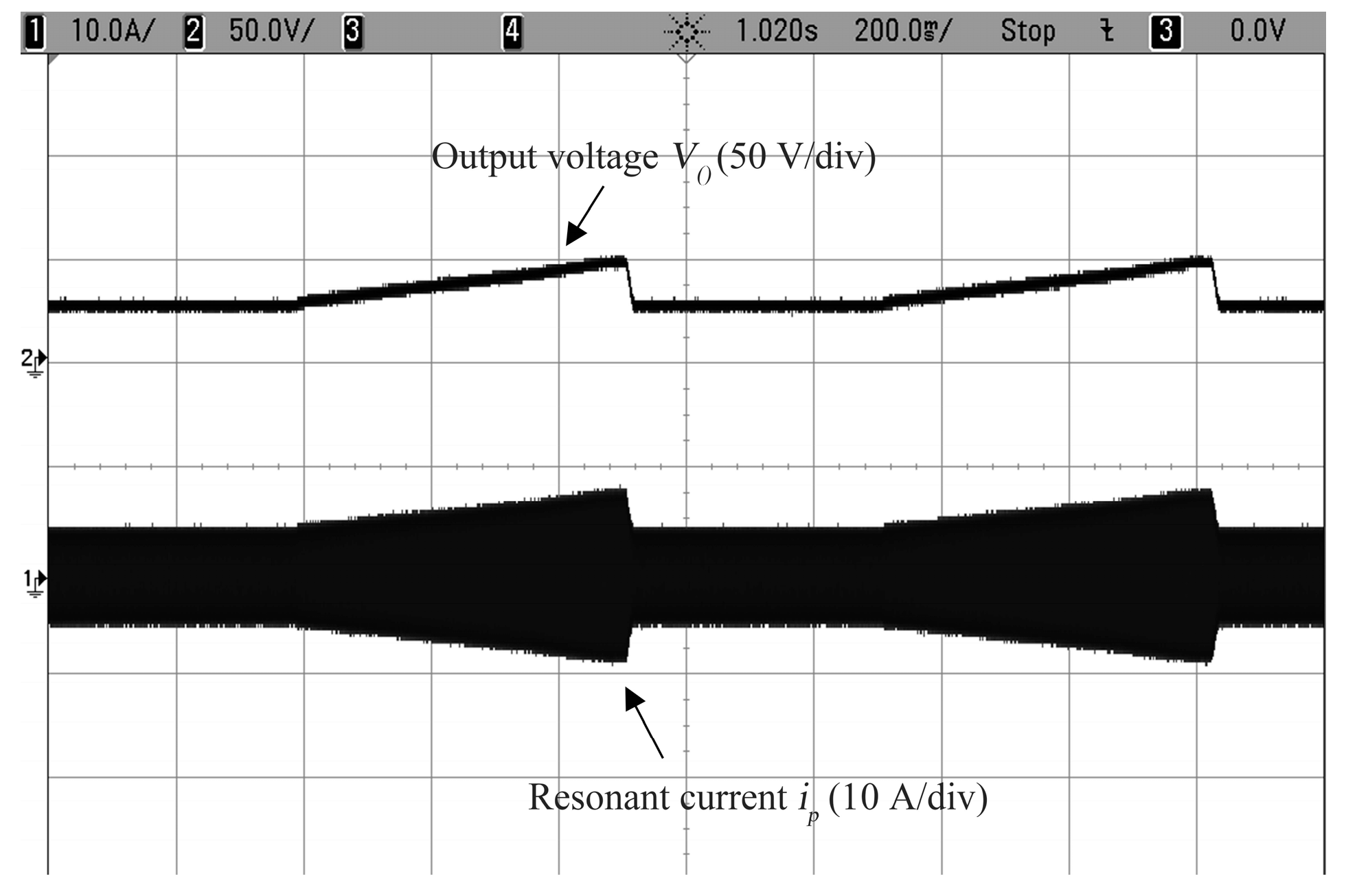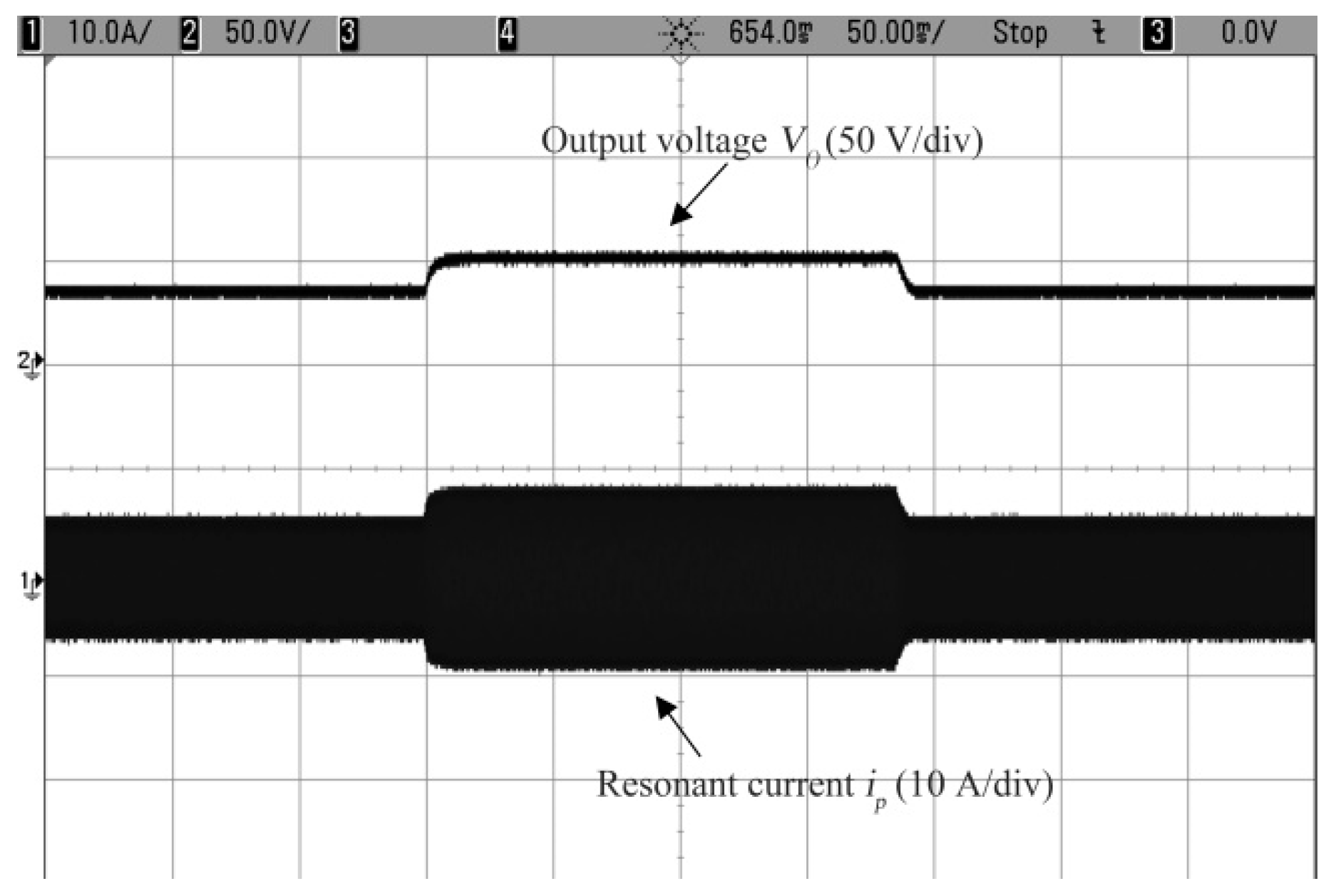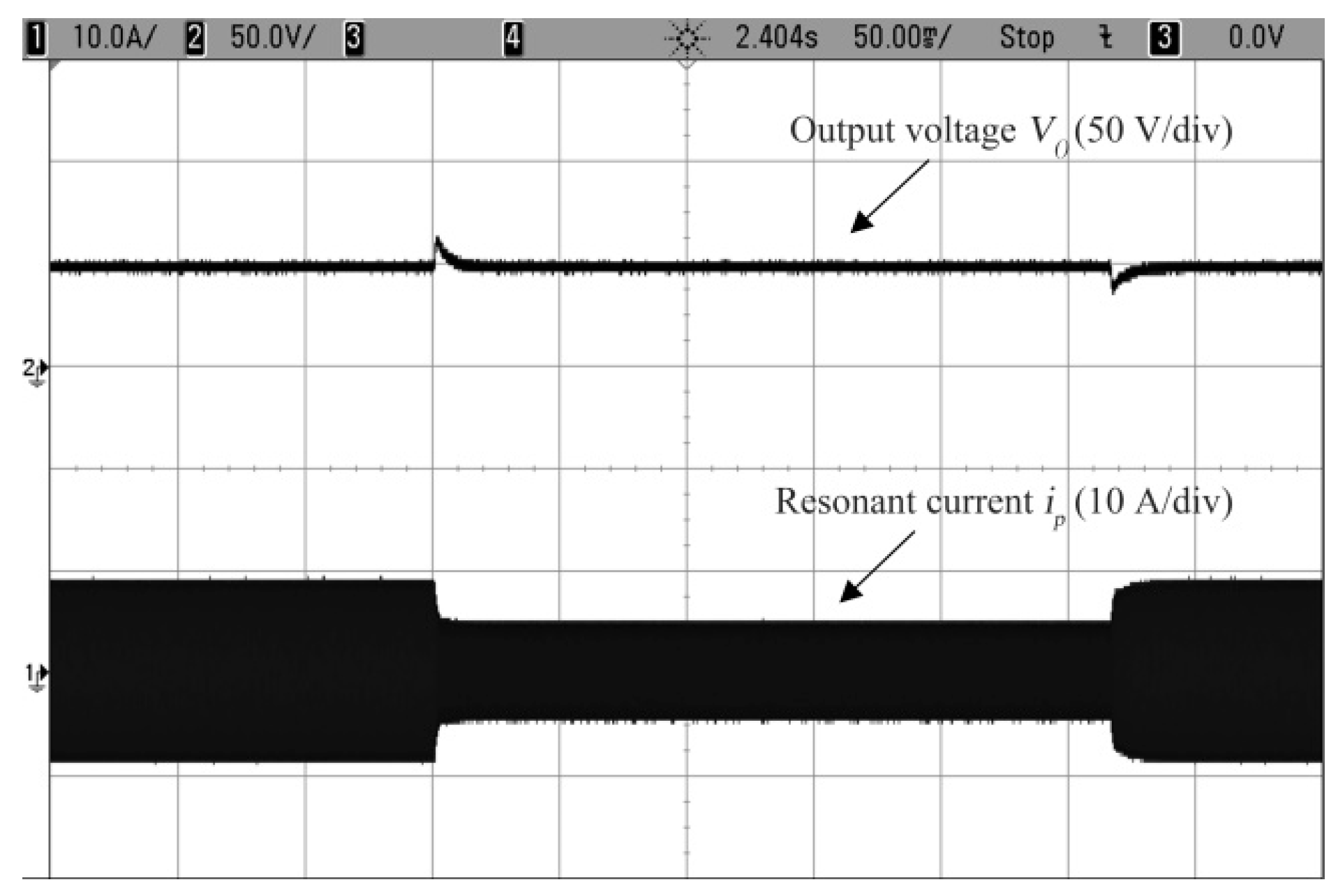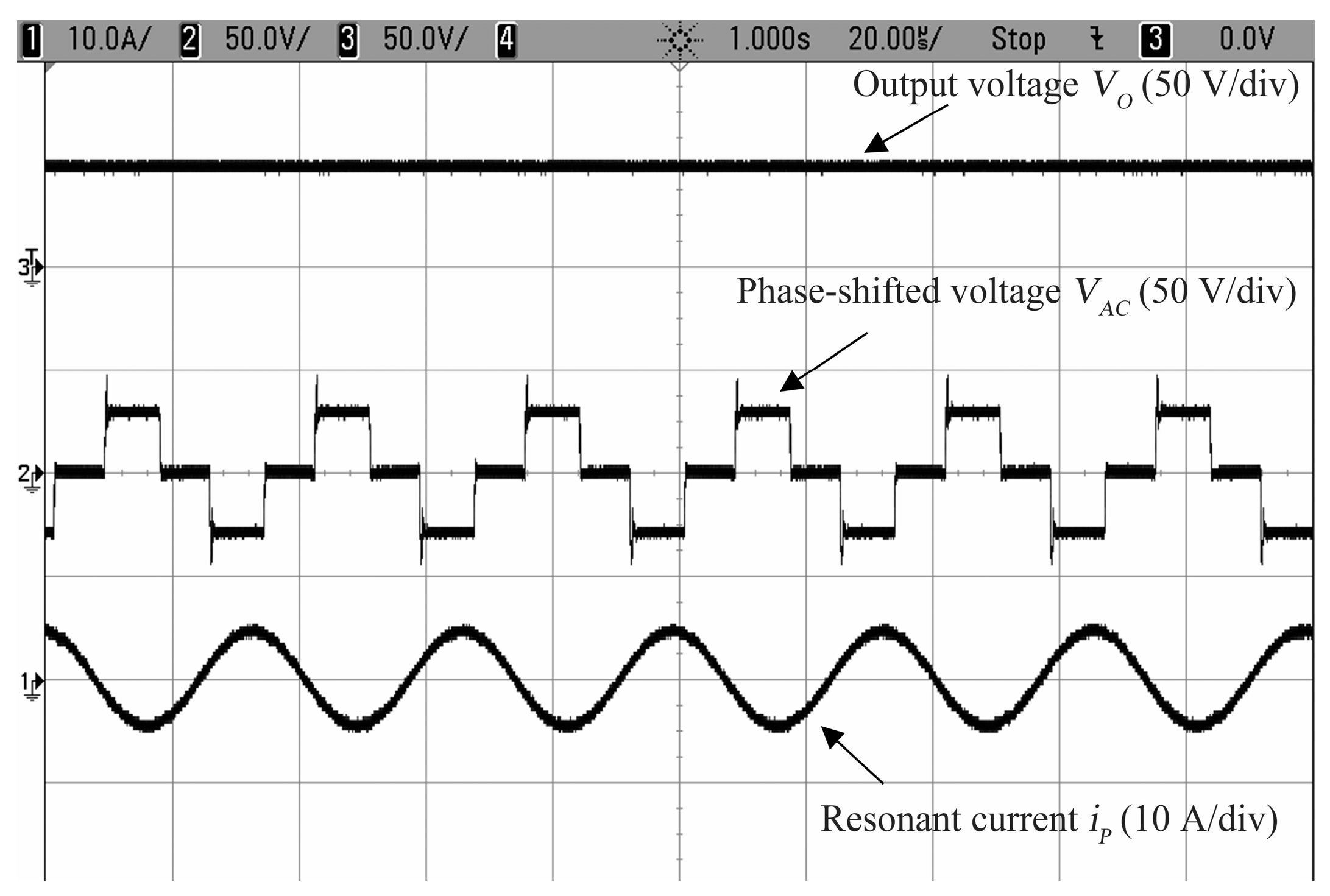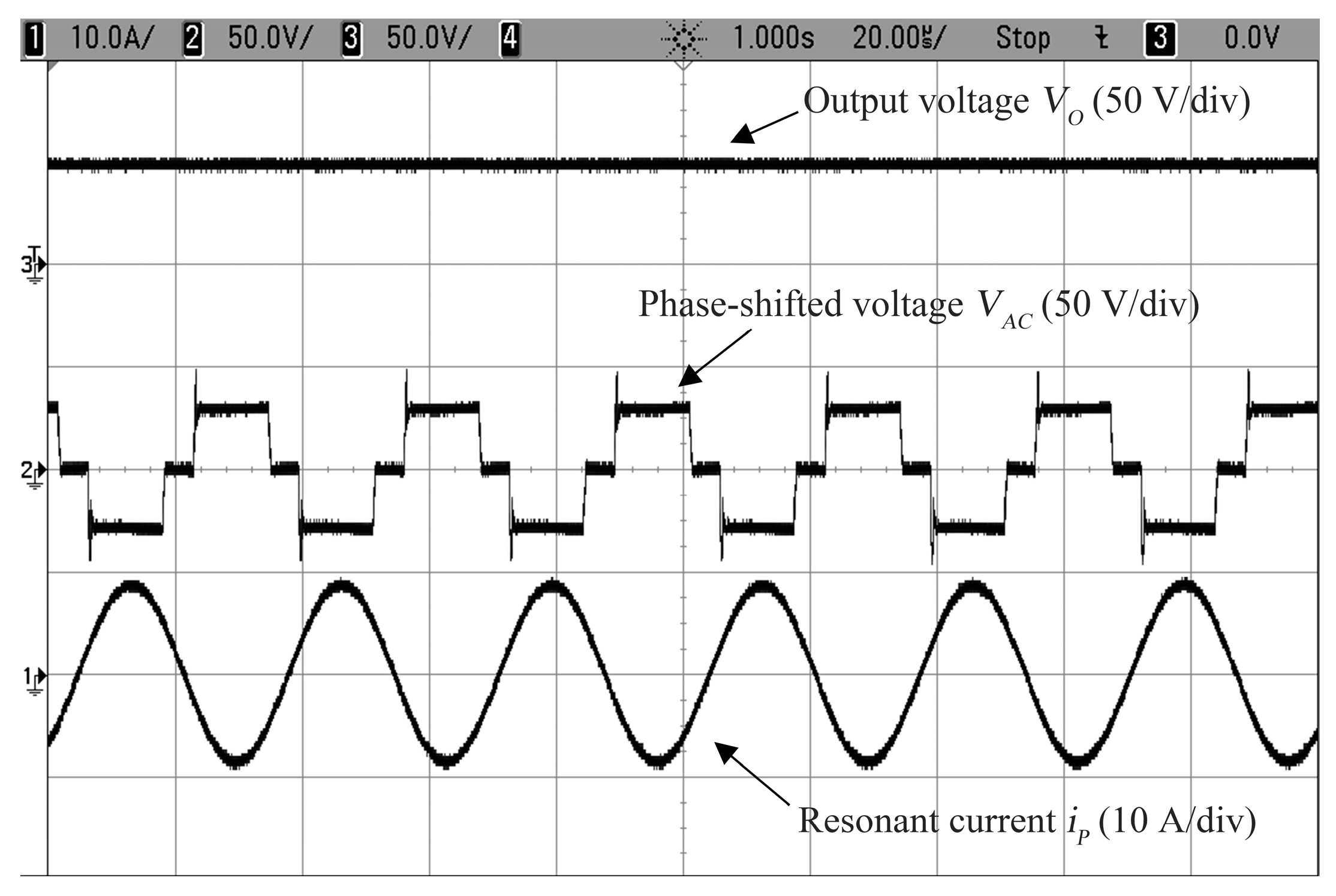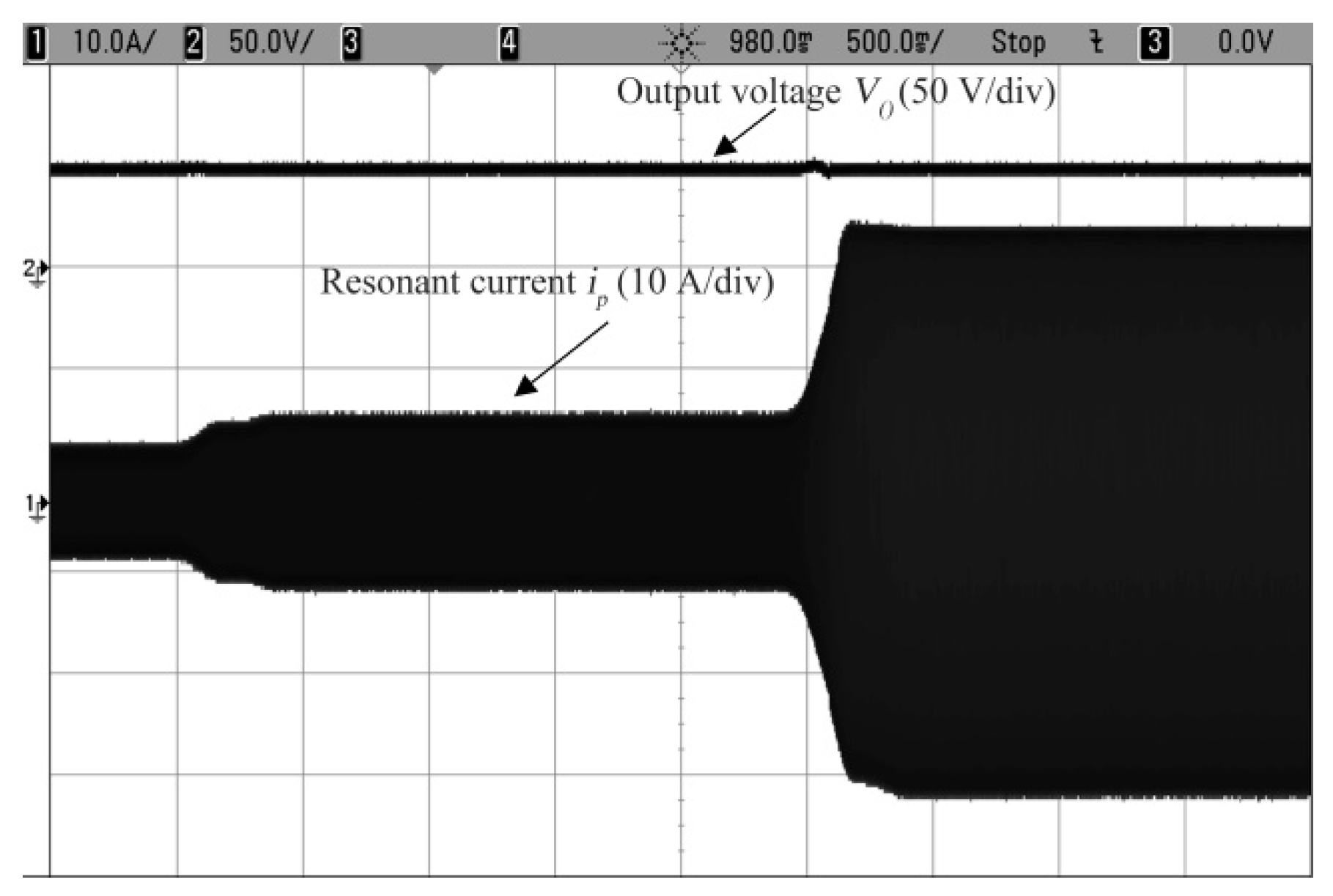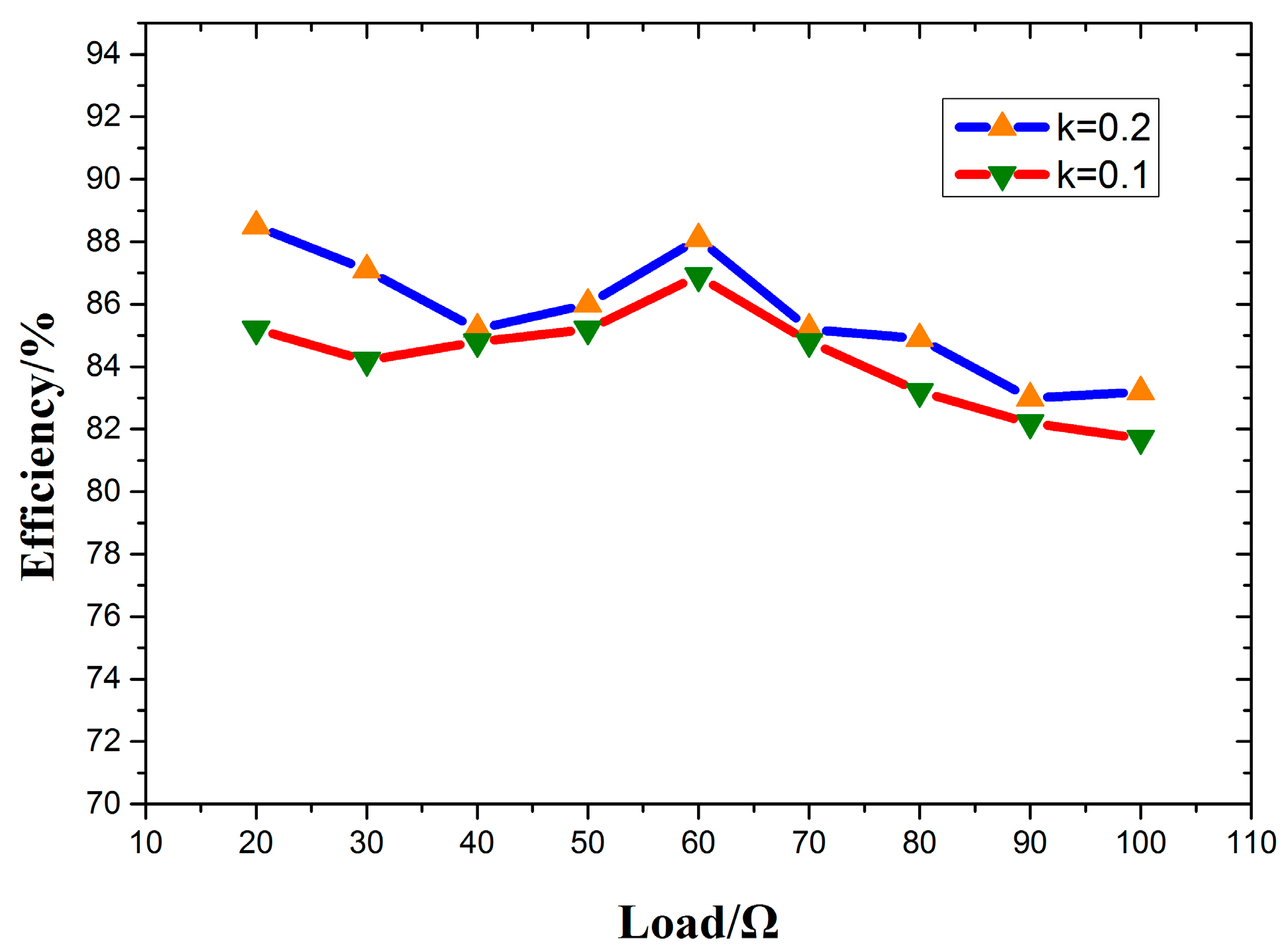1. Introduction
Wireless Power Transfer (WPT) is a novel technology that can realize efficient energy transmission between two electrically isolated coils by high frequency magnetic coupling. As the magnetic field is used as energy transmission media, the process of energy transmission is unaffected by water or dirt and is intrinsically safe for human beings and animals [
1,
2]. In recent years, WPT technology has found more and more applications in mobile robots and microrobots used in the human body [
3,
4,
5].
A robot power supply WPT system is characterized by loose magnetic field coupling and resonant operation, which results in system parameter uncertainty. Many circuit parameters such as the coil inductances, coupling coefficients, and reflecting impedance may vary dynamically during operation. Firstly, the coupling variation when the robot is moving may lead to significant variation in the mutual inductances. Due to relatively large movements between the primary and secondary sides, the mutual inductance may randomly drift away from the designed value [
6,
7,
8]. Secondly, the load may vary under different output power requirements for a robot’s different action requirements. The third uncertain parameter is the operating frequency. Due to soft switching requirements, the switching frequency should dynamically change according to the inherent frequency variation of the resonant tank. It should be noted that the inherent frequency is also an uncertain parameter affected by the mutu1al inductance, the load, and other parameters [
9]. These multiple uncertain parameters will greatly increase the complexity of the system behaviors. Moreover, due to existence of the resonant tank, the WPT system often exhibits high system orders. For example, in a composite resonant type system such as LCL (L-inductor, C-capacitor, L-inductor), the system order can reach 7 or even higher [
10]. The multiple uncertain parameters, high system order, and switching nonlinearity will make the system modeling and control extremely difficult [
10]. In short, these dynamical variations of system parameters will bring system with uncertainty and influence system performance. Therefore, it is necessary to put forward a robust control method for robot wireless power transfer systems.
The classical control of a WPT system is mainly focused on a single objective such as tuning point control and power flow control. Hysteretic Bang-Bang control and PID (Proportion Integration Differentiation) control are two typical control methods. Although these control methods are easy to implement [
2,
11,
12,
13], they normally cannot fulfill multi-objective and robust performance requirements. As a result, more attention is being paid to advanced control methods. Recent research work can be categorized into sliding mode control [
14], fuzzy control [
15], optimal PID control [
16] and robust control method [
10]. For sliding mode control, an adaptive sliding-mode control method is proposed for WPT system [
14]. This method can realize output power control for multiple users system, but prior knowledge is required for sliding mode surface design. For fuzzy control, a full directional tuning control method by using a fuzzy logic control method is proposed [
15]. The logic control is used to determine the tuning step-size to overcome the chattering effects of using a fixed tuning step-size. For PID control, aiming at the PID tuning problem, a derivative-free optimization technique based on a genetic algorithm is proposed [
16]. The PID parameters can be optimized by this offline calculation algorithm. The main feature of the Bang-Bang, PID, and fuzzy and sliding mode control methods is the independence of the system model, therefore avoiding the model complexity problem. However, these control methods are single-objective control methods and the robustness uncertain parameters variation cannot be taken into account. When the system parameters drift randomly, these controllers may not achieve good control performance. Furthermore, since the controller design process is independent of the system model, a trial-error method is often used to determine an optimal set of controller parameters, especially for a PID controller. Robust control is another method based on comprehensive system modeling. All system parameters including the uncertain parameters are embedded in the system model. A distinguishing feature of the robust control method is its multi-objective control characteristics. It can guarantee the output stability, reference tracking, anti-perturbation performance, as well as control energy optimization at the same time. It is relatively easy to design the controller by following a routine design process.
The current research on robust control of WPT is still at its initial stage. In 2013, Li et al. proposed a
μ-synthesis robust control method for WPT systems [
10]. In the paper, only frequency uncertainty was taken into account, but it is difficult for the mutual inductance to be separated from the system model because this parameter appears in cross-coupling differential equations. Furthermore, traditional
μ-synthesis control methods cannot be used in a system with multiple uncertain parameters including mutual inductance because these multiple uncertain parameters will increase the order of the uncertainty block and it is very difficult for the D-K iteration in the
μ-synthesis control to converge. In addition, a real buck converter may need to be added to regulate the primary DC input [
10], which increases the system complexity and slows down the system response speed.
Aiming at the robust control and anti-perturbation performance improvement for robot power supply, this paper proposes a novel H∞ robust control method for the WPT system with multiple uncertain parameters. Firstly, instead of using a real power converter, a virtual buck converter is developed using a phase-shifted inverter to regulate the equivalent DC input voltage. Secondly, a Generalized State Space Averaging (GSSA) model is established based on a differential system modeling. Thirdly, the paper proposes a multiple uncertain parameters modeling method by upper Linear Fractional Transformations (LFT). Based on the new model, the design method of a H∞ suboptimal controller is proposed. The controller stability and performance based on Structure Singular Value (SSV) are analyzed.
The main achievement of this paper is finding a robust control method which can take uncertain coupling coefficient into robust control. Traditionally, it’s very difficult to detach this uncertain parameter from the system model due to the complexity of the cross coupling equations. The other achievement is finding a virtual buck converter to implement robust control for phase-shift converter, which can be applied to any other system.
3. GSSA Modeling
Due to the existence of switching nonlinearity, classical linear modeling methods cannot be directly used. The GSSA modeling method is a nonlinear modeling method, which can be used to solve the modeling problem for power electronics systems. This paper utilizes the GSSA modeling method to transform the nonlinear model in the time domain to a linear state space model in the frequency domain. The first step of GSSA modeling is to set up the differential model based on the equivalent system model, which is shown in
Figure 4.
According to the equivalent circuit, the differential model of the LCL system can be obtained as:
where
RLr,
RLp and
RLs are the equivalent series resistances of the inductances
Lr,
LP and
LS, respectively. The
fp(
t) and
fs(
t) are switching functions which have a 180° phase difference. They are given by:
The GSSA method is based on the concept that a signal
x(
τ) can be approximated on the interval
to arbitrary accuracy with a Fourier series expansion
where
ω = 2π/
T =
2π
f.
T is the chosen period of fundamental harmonic. The time-dependent complex Fourier coefficient
is the index-n coefficient, given by
The key point of the GSSA method is to substitute the complex Fourier coefficient
for the time domain signals
x(
t). In the WPT system, for the state variables exhibiting predominantly sinusoidal-type behavior, they can be replaced by their index-one coefficients (
). For the state variables exhibiting predominantly constant (or slowly varying) behavior, they can be replaced by their index-zero coefficients (
) [
19].
The GSSA model of the LCL type WPT system can be obtained as:
where
.
However, since all
are complex Fourier coefficients, it’s not convenient for controller design. Therefore, these complex state variables are detached to variables of real part and variables of imaginary part respectively, which can be shown as:
The output voltage
Vo is set as the output
y which is equal to
Vf. Then the GSSA model is obtained as:
where
.
4. Multiple Uncertain Parameters Modeling
The mutual inductance M, running frequency ω and load parameter RL are three primary uncertain parameters. They are defined as , and , respectively. , and are the nominal values of ω, RL and M while , and represent the maximum variation range of these parameters. The variables , and are normalized uncertain variables in the interval [−1, 1].
Furthermore, these uncertain parameters can be expressed using upper LFT method. LFT method is utilized to detach the uncertain part from the system model:
The block diagrams of these LFTs can be shown in
Figure 5:
By substituting these LFT of uncertain parameters into system GSSA model given in (10), and extracting the uncertainty coefficients from the GSSA model, the uncertain part can be detached from the system model by a special composite upper LFT method proposed in this paper. The detailed procedure of this process is given in
Appendix A. The system model after uncertain part detachment is shown in
Figure 6.
In
Figure 6, the
Gnom block is the system model with all certain parameters and the Δ block is the uncertain model part including all normalized uncertain variables. The perturbed input
h and perturbed output
q are defined as:
The state space representation of
Gnom is given as:
where
is the coefficients matrix of the
Gnom.
5. H∞ Suboptimal Controller Design
In order to realize multi-objective control, it is necessary to set a cost function to take into account the performance requirements including reference tracking, anti-perturbation and control energy limitation. Based on these requirements, the system structure can be established by using mixed sensitivity optimization design, which is shown in
Figure 7.
Here
Gnom(
s) is the nominal system of
G(
s), which denotes the system without uncertainty.
K(
s) is the transfer function of the output feedback controller.
Wp(
s) and
Wu(
s) are a performance weighting function and control weighting function, respectively. Signals
d(
t),
w(
t) and
u(
t) are perturbation, measured error and control input. The two weighted outputs
zp(
t) and
zu(
t) are performance indexes output which can be grouped into a performance output vector
z(
t), which denotes system performance requirements. Thus the transfer function matrix from
d(
t) to
z(
t) can be obtained as:
where
S(
s) is the sensitivity function which combines multiple robust control objectives and
R(
s) is the control sensitivity function. The mixed sensitivity H
∞ suboptimal control method is to find a controller
K(
s) which can stabilize the closed-loop system in
Figure 6. That is, for a given small scalar
γ > 0, the controller
K(
s) should satisfy:
This cost function in (18) combines the design objectives of reference tracking, anti-perturbation, less control energy and robust stabilization together. With the cost function, the H
∞ robust control system will be as shown in
Figure 8.
where
P(
s) is called the generalized plant model which includes the nominal model
Gnom and weighting function
Wp and
Wu. It can be given by:
where
is the augmented coefficient matrix. The cost function in (16) can be redefined as: Given a positive number
γ, to find a stabilizing controller
K(
s) satisfying H
∞-norm of the closed-loop transfer function less than
γ. It can be given by:
where
.
In the controller design stage, since multiple uncertain parameters are involved, the dimension of the uncertainty block will be 35 × 35 (corresponding to δω, δRL and δm). As far as the μ-synthesis control method is concerned, the 35 × 35 uncertainty block will cause the D-K iteration algorithm to fail to converge. Thus the μ-synthesis control method cannot be applied. However, the H∞ suboptimal control is a signal-based control algorithm utilizing the H∞ norm. This control method can obtain more freedom in designing high order robust controller and it can also obtain good robust performance and robust stability against system perturbations.
In selecting the weighting function, normally the performance weighting function
Wp(
s) is designed as a high gain low-pass filter to emphasize the tracking accuracy at low frequencies. Hence, the weighting function
Wp(
s) is selected in the form of first-order transfer function as:
The control weighting function
Wu(
s) is usually chosen as a high-pass filter or just a scalar to limit the control energy and actuator saturation [
20].
After uncertainty modeling and weighting functions selection, the suboptimal H
∞ controller design can be realized with aid of the Robust Control Toolbox of MATLAB. Based on the generalized plant model
P(
s), the robust controller
K(
s) can be directly obtained using the
hinfsyn function. The form of function call is hinfsyn (
P, nmeas, ncon, gmin, gmax, tol), where
P denotes
P(
s) model, nmeas and nmeas are the numbers of output and control input. Parameters gmin, gmax and tol are the lower and upper bound and tolerance of
γ, respectively. The order of the obtained controller is 13. In order to make it easy for implementation, the controller order needs to be reduced. Based the optimal Hankel-norm approximation of a system matrix, the controller order is reduced to 3 using hankmr function. The form of function call is hankmr (sys, sig, k, opt), where parameter sys and sig denotes system model. Parameter k denotes the reduced order. Furthermore, in order to make the controller suitable for digital CPU implementation such as DSP, the discretization of controller is carried out using the
samhld function. The form of function call is samhld (sys, T), where parameter sys denotes system model and T is the discretization sampling period. In summary, the whole robust controller design procedure can be as represented by
Figure 9.
6. Analysis of H∞ Controller
In order to analyze the performance and stability of robust controller, a demo system is set up. To stay consistent, all parameters in controller computation, analysis, simulation and experiments are kept the same, and they are listed in
Table 1 and
Table 2.
The weighting function is given by
and the control weighting function is selected as
. The upper bound of performance index
γ is set at 0.5. Then the obtained controller
K(
s) is given by:
The achievable minimum value of γ for is 0.0039. This demonstrates that this closed-loop system has a good robust performance.
In order to gain a deep insight of the performance of the H∞ suboptimal controller K(s), the structured singular value analysis (μ analysis) method can be used to evaluate the robust stability and robust performance of the closed-loop system.
Based on the generalized plant model
P(
s) (19) and the H
∞ suboptimal controller
K(
s) in
Section 5 a standard
J-Δ
f configuration for
μ analysis can be obtained as shown in
Figure 10. In
Figure 10,
J(
s) is the transfer function matrix obtained via the lower LFT technique, i.e.,
. The uncertainty block is given as
and
is the performance uncertainty block.
First, the robust stability analysis is given. It shows the controller ability to maintain system output stability on the condition of uncertain parameters variation. The upper and lower bounds of
over a certain frequency range are shown in
Figure 11.
Figure 11 shows that in the frequency interval [10
−2 10
6] (rad/s), the peak value of
μ is 0.936 which indicates
< 1 is satisfied. It shows that the system stability can be maintained for all Δ satisfying
||Δ
||∞ < 1/0.936. Hence, when the multiple uncertain parameters vary in the range given in
Table 1, the robust stability can be guaranteed.
Secondly, the robust performance analysis is given. It shows that the ability of the controller to eliminate the perturbation from the uncertain parameters. Since the performance output
z(
t) in
Figure 10 is a 2-dimensional vector, the performance uncertainty block Δ
P is defined as a 1 × 2 full block. The total structured uncertainty block Δ
f is defined as:
The upper and lower bounds of
over a certain frequency range are shown in
Figure 12.
In
Figure 12, the peak value of
is equal to 0.871. It demonstrates that the closed-loop system achieves good robust performance for all Δ satisfying
||Δ
||∞ < 1/0.871. Hence, the robust performance can be guaranteed when the perturbations from the uncertain parameters are within the range given in
Table 1.
7. Simulation Results
In order to verify the H
∞ control method, a simulation model is set up using Simulink as shown in
Figure 13. In this model, to make the controller easy for implementation in digital processing unit, the discretized robust controller based on (22) is given by:
The output voltage Vo is compared with a reference voltage to produce error signal e. The discretized H∞ controller produces control output u based on the error signal e. The phase-shifted angle is calculated with u according to Equation (5).Then this angle is converted to the driving signal for the phase-shifted inverter.
In order to evaluate the dynamic performances of the closed-loop system with the H∞ controller, the ramp and step reference tracking, load perturbations tests were carried out.
First, the simulation of the closed-loop system with a ramp reference was carried out and the reference was a ramp signal varied from 24 V to 48 V. The simulation result is shown in
Figure 14.
Figure 14 shows that the output voltage
Vo was able to track the ramp reference signal rapidly while the resonant current
ip changes from 4.8 A to 9.8 A. It denotes the controller has a good tracking ability for continuous varying reference. Secondly, the reference jump test was carried out to show the performance of the closed-loop system. The reference jumps was designed in the sequence of 32 V–48 V–32 V. The simulation result is shown in
Figure 15.
Figure 15 shows that with the H
∞ control, the output voltage
Vo can track the reference variation (32 V–48 V and 48 V–32 V) within 10 ms and there are no overshoot in the adjusting process. Thus, based on the results shown in
Figure 14 and
Figure 15, it can be concluded that closed-loop system has achieved the fast and accurate dynamic tracking performance with the H
∞ controller.
Thirdly, to verify the robustness of the closed-loop system under load perturbation, simulation results were obtained on the condition of load resistance variation. The control aim is to maintain the output voltage stable at 48 V. The load resistance variation is set in the sequence of 50 Ω–100 Ω–50 Ω. The simulation result can be shown in
Figure 16.
Figure 16 shows that for the first load jump from 50 Ω to 100 Ω, it takes about 8 ms to complete the control regulation and there is a 12 V voltage overshoot in the process. For the second load jump from 100 Ω to 50 Ω, it takes 10 ms to complete control regulation and there is 8 V overshoot. The simulation results show the controller has a good anti-perturbation ability for load variation.
In
Figure 17 and
Figure 18, the zoomed waveforms of the output voltage
Vo, phase-shifted voltage
VAC, and resonant current
iP in the steady state under different load conditions. Regardless of 50 Ω or 100 Ω load conditions, the output voltage
Vo, the phase-shifted voltage
VAC and the resonant current
iP are stable and there is no ripple on the output voltage and phase-shifted voltage. Moreover, there is also no distortion on the resonant current. It shows that the controller also has a good performance in the system steady state.
8. Experimental Results
An experimental system was set up for verification. The system structure and a photo can be seen in
Figure 19.
In the experimental system, an IRF 540 MOSFET was used for the switching components S1–S4. The primary and secondary coils (LP and LS) were made by Litz wire with 24 turns and 15 cm diameter. RF-link was built up by nRF2401 RF module working at 2.4 GHz to realize information exchange.
The discretized H∞ controller in (24) is implemented on a TMS320LF2407 DSP microcontroller. The output voltage Vo is sampled and sent to the primary side by using the RF-link. According to the output voltage, the DSP will calculate the control output and corresponding phase-shifted angle. The phased-shifted pulses are produced by the gate drive block to the inverter. A ZCS detection block is used to realize zero current switching (ZCS). However, due to the phase-shifted requirement, the ZCS operation cannot be guaranteed for all switching process.
For verification, several experiments were carried out. First, the test of ramp reference tracking was implemented. The response of the closed-loop system with ramp reference starting from 24 V to 48 V is shown in
Figure 20. The output voltage
Vo can track the ramp reference smoothly with the peak value of the resonant current
ip varying from 5 A to 8.5 A.
Firstly, his test of reference jump was carried out. The response of voltage reference jumping from 32 V to 48 V and then returning to 32 V is shown in
Figure 21. It takes 12 ms and 11 ms to complete the control regulation for the first and second reference jump, respectively. There are no significant overshoots and ripples on either output voltage
Vo or resonant current
ip. From
Figure 21, it can be concluded that the H
∞ controller can achieve good dynamic tracking performance.
Secondly, the test of load perturbation was carried out. The response of load resistance jumping from 50 Ω to 100 Ω and then returning to 50 Ω is shown in
Figure 22. The control aim is to maintain output voltage at 48 V.
For the first load jump, there is 11 V overshoot and 14 ms adjustment time before entering the steady state. For the second jump, there is 11 V overshoot and 12 ms adjustment time. The experimental results show the controller can achieve good anti-perturbation performance. In
Figure 23 and
Figure 24, the zoomed waveforms of the output voltage
Vo, phase-shifted voltage
VAC and resonant current
ip in the steady state under different load conditions.
In
Figure 23 and
Figure 24, the output voltage
Vo and phase-shifted voltage
VAC are stable and the waveforms of resonant current
ip are sinusoidal with low distortion. It shows the controller also has a good steady state performance.
Finally, aiming at moving robot power supply, the test of mutual inductance variation was carried out. The variation of mutual inductance was implemented by producing rapid lateral moving between the primary and secondary coil, as shown in
Figure 25.
The response of the closed-loop system with
M changes in the sequence of 24.1 µH–14.1 µH–7.1 µH is shown in
Figure 26. The control aim is to maintain the output voltage stable at 48 V.
Figure 26 shows that the output voltage
Vo is controlled at 48 V with mutual inductance variation. When the system has a relatively strong coupling (
M equals 24.1 µH), the amplitude of the resonant current
ip, is controlled low to limit the power transfer. However, when the system has a weak coupling (
M equals 7.1 µH), the amplitude of
ip was controlled high to guarantee required power transfer. It will be beneficial for reducing unnecessary power losses in the primary coil. Therefore, the control method can not only obtain good anti-perturbation performance for mutual inductance variation, but also optimize the energy transmission performance.
To evaluate the controller performance on system efficiency, an experimental test was carried out. In the robust control, system efficiency is measured on the condition of coupling coefficient and load variation. The experimental results can be shown in
Figure 27.
As can be seen, when coupling coefficient equals 0.1, system efficiency varied from 81% to 85% with load resistance variation from 10 to 100. When coupling coefficient equals 0.2, system efficiency varied from 83% to 88%. The results show this robust control method can achieve relatively high efficiency. With the robust control, the required resonant current can be regulated according to actual load requirement. The power losses on the primary and secondary coil can be significantly reduced when compared with traditional constant resonant current mode.
